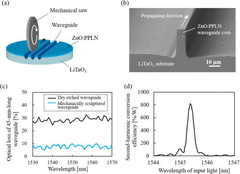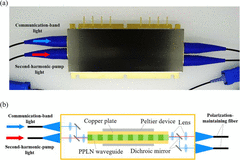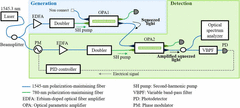


NTT:ラックサイズで大規模光量子コンピューターを実現(動画):
NTT: Realizing a large-scale photon computer in a rack size:
NTT:实现机架尺寸的大型光子计算机:
~光ファイバー結合型量子光源の基幹技術開発に成功~
開発の概要:
光源モジュールを実現:
「ラックサイズで大規模光量子コンピューター」を実現するため、
基幹デバイスとなる「光ファイバー接続型高性能スクィーズド光源モジュール」を開発しました。
光通信用光学部品を使用:
「光ファイバー結合型量子光源モジュール」と「光通信用光学部品」を用いました。
- 6テラヘルツ以上の広帯域にわたり、
- 量子ノイズが75%以上圧搾された、
- 連続波のスクィーズド光の生成に、
世界で初めて光ファイバー光学系で成功しました。
光量子コンピューター開発に貢献:
本成果は、
「光通信デバイスで、安定的かつメンテナンスフリーな閉じた系」を開発したもの。
「現実的な装置規模での光量子コンピューター開発」を可能としました。
今後、実用機の開発が大きく前進します。
量子コンピューター:
- 重ね合わせ状態と量子もつれ状態という、
- 量子力学特有の現象を利用したもの、
- 超並列計算処理が可能です。
光量子コンピューターの強み:
世界各国で研究開発が進められています。
現在さまざまな方式が考案されました。
その中でも、
「光の量子である光子で計算する光量子コンピューター」には、多くの強みがあります。
実用的な小型化が可能:
- 例えば、
- 他の方式で必要とされる冷凍・真空装置が不要なため、
- 実用的な小型化が可能です。
量子ビット数を無限に増加:
「連続的に量子もつれ状態を作ること」が出来ます。
「集積化や装置の並列化なしに、量子ビット数をほぼ無限に増すこと」ができます。
光広帯域性を生かした高速な計算:
- 光の広帯域性を生かした高速な計算処理も可能です。
- もちろん、量子誤り訂正もできます。
さらに、
- 1つの光子で量子ビットを表すのではなく、
- 多数の光子で量子ビットを表す手法で、
「光子数の偶奇性を用いた量子誤り訂正ができること」も理論的に示されています。
光通信技術との親和性:
この方式は、光通信技術とも親和性が高い。
- 通信波長帯の低損失な光ファイバーや、
- 光通信での高機能光デバイスを用いて、
実機構築に向けた飛躍的な発展が期待できます。
https://www.jst.go.jp/pr/announce/20211222-2/index.html
光量子コンピューター研究支援基金 | 東京大学基金
https://utf.u-tokyo.ac.jp/project/pjt93?reportId=pjReportDetail1
Fabrication of low-loss quasi-single-mode PPLN waveguide and its application to a modularized broadband high-level squeezer:
Applied Physics Letters: Vol 119, No 25
ABSTRACT
A continuous-wave (CW) broadband high-level optical quadrature squeezer
is essential for high-speed large-scale fault-tolerant quantum computing on a time-domain-multiplexed continuous-variable optical cluster state.
CW THz-bandwidth squeezed light
can be obtained with a waveguide optical parametric amplifier (OPA);
however,
the squeezing level has been insufficient for applications of fault-tolerant quantum computationbecause of degradation of the squeezing level due to their optical losses caused by the structural perturbation and pump-induced phenomena.
Here,
by using mechanical polishing processes, we fabricateda low-loss quasi-single-mode periodically poled LiNbO3 (PPLN) waveguide,
which shows 7% optical propagation loss with a waveguide length of 45 mm.
Using the waveguide,
we assembled a low-loss fiber-pigtailed OPA modulewith a total insertion loss of 21%. Thanks to its directly bonded core on a LiTaO3 substrate,
the waveguide does not show pump-induced optical loss even under a condition of hundreds of milliwatts pumping.Furthermore,
the quasi-single-mode structure prohibits excitation of higher-order spatial modes and enables us to obtain larger squeezing level.Even with including optical coupling loss of the modularization,
we observe 6.3-dB squeezed light from the DC component up to a 6.0-THz sideband in a fully fiber-closed optical system.
By excluding the losses due to imperfections of the modularization and detection,
the squeezing level at the output of the PPLN waveguide is estimated to be over 10 dB.
Our waveguide squeezer
is a promising quantum light source for high-speed large-scale fault-tolerant quantum computing.